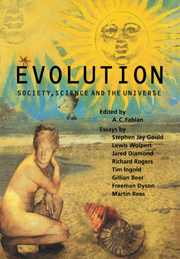Book contents
- Frontmatter
- Contents
- Introduction
- 1 On Transmuting Boyle's Law to Darwin's Revolution
- 2 The Evolution of Cellular Development
- 3 The Evolution of Guns and Germs
- 4 The Evolution of London
- 5 The Evolution of Society
- 6 The Evolution of the Novel
- 7 The Evolution of Science
- 8 The Evolution of the Universe
- Notes on Contributors
- Acknowledgements
- Index
3 - The Evolution of Guns and Germs
Published online by Cambridge University Press: 25 January 2010
- Frontmatter
- Contents
- Introduction
- 1 On Transmuting Boyle's Law to Darwin's Revolution
- 2 The Evolution of Cellular Development
- 3 The Evolution of Guns and Germs
- 4 The Evolution of London
- 5 The Evolution of Society
- 6 The Evolution of the Novel
- 7 The Evolution of Science
- 8 The Evolution of the Universe
- Notes on Contributors
- Acknowledgements
- Index
Summary
This chapter sets itself the modest task of explaining the broad pattern of history on all the continents for the last 13 000 years. Why did history take such different courses for peoples of different continents?
Eurasians, especially peoples of Europe and eastern Asia, have spread around the globe. They and their overseas descendants now dominate the modern world in wealth and power. Other peoples, including most Africans, survived and have thrown off European domination but remain far behind in wealth and power. Still other peoples, including the original inhabitants of Australia, the Americas and southern Africa, are no longer masters of their own lands but have been decimated, subjugated and even exterminated by European colonialists. Why did history turn out that way, instead of the opposite way? Why were American Indians, Africans and Aboriginal Australians not the ones who conquered or exterminated Europeans and Asians?
This question can easily be pushed back one step further. By the year A.D. 1500, the approximate year when Europe's overseas expansion was just beginning, peoples of the different continents already differed greatly in technology and political organization. Much of Eurasia and North Africa was occupied by Iron Age states and empires, some of them on the verge of industrialization. Two Native American peoples, the Incas and Aztecs, ruled over Stone Age or nearly Bronze Age empires. Parts of sub-Saharan Africa were divided among small indigenous Iron Age states or chiefdoms. All peoples of Australia, New Guinea and the Pacific Islands, and many peoples of the Americas and sub-Saharan Africa, lived as Stone Age farmers or hunter–gatherers.
- Type
- Chapter
- Information
- EvolutionSociety, Science and the Universe, pp. 46 - 63Publisher: Cambridge University PressPrint publication year: 1998



